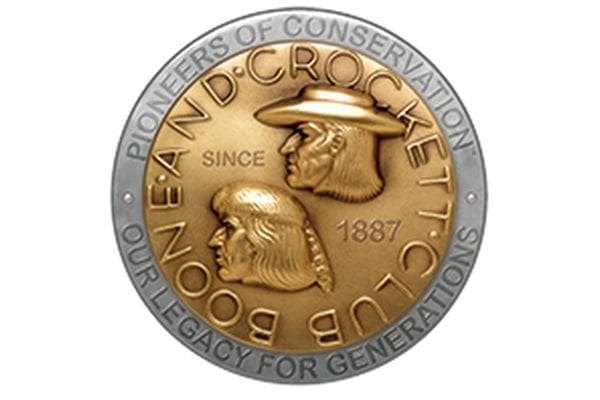We may earn revenue from the products available on this page and participate in affiliate programs. Learn more ›
Humminbird fish finders were born in—and still live in—the bass and inshore fishing world. Started in 1971 in Eufaula, Alabama, and spearheaded by Tom Mann, Humminbird’s first depth flasher brought deep-water bass fishing to the masses, especially tournament anglers. That started an arms race among sonar manufacturers to have the best electronics possible. To stay at the head of the competition, Humminbird set milestones in digital displays and high-powered sonar. The iconic black and gold fish finders are on the boats of the best fishermen in the game.
Today, Humminbird continues to be on the cutting edge of side-imaging fish finders, along with down-imaging and live-view sonar technology. From the simplest fish finder to the most advanced marine electronics, Humminbird emphasizes intuitive controls and user-friendly features. We’ve tested some of the best Humminbird fish finders out on the water and reviewed them each below so you can find one that fits your style of angling.
The Best Humminbird Fish Finders
How We Picked The Best Humminbird Fish Finders
When it comes to crowning the best Humminbird fish finders, we could have picked the most expensive model with the most features. But that’s not fair to anglers on a budget. So, we looked for the best one most people could afford and that can fit in almost any boat or watercraft.
To meet these criteria, a fish finder doesn’t have to do it all. But it must perform at the top of its class. We looked at fish finder display, sonar signals, available options, and transducers. Then we examined navigation for accuracy and accessibility. We’ve discovered that a fish finder with the features we need is easier to use than a more advanced model with complicated options. Easy access and the features most anglers need weighed highly in our testing.
Best Overall
Pros
- Excellent price point
- Compact and versatile
- Good target separation
Cons
- Not upgradeable for more advanced imaging
We didn’t choose the most expensive or the most feature-rich model as the best Humminbird fish finder for most anglers. Instead, we chose the Humminbird Helix 5 CHIRP DI GPS G3, which has all the features most people need without anything extra. The buttons and menus are simple and easy to navigate. For a clear view of structure and fish below the boat, CHIRP sonar sends a long pulse of energy into the water and uses two signals for a simple and clean display. For the average angler, this is a great entry point that will serve well for years of fishing fun.
On the chartplotter side of the package, Humminbird’s base maps are detailed enough for basic navigation with the option to upgrade to more accurate maps. The 5-inch screen is large enough to see from a distance, but small enough to fit on a skiff or paddle craft.
Our only real complaint is that this unit can’t be upgraded with more sonar options like side imaging and mega live. However, for anglers who later decide they want to upgrade it’ll be an easy unit to resell because it’s so practical for a wide spectrum of anglers.
Specs
- Screen Size: 5 inches
- Display Pixel Matrix: 800 x 400
- Sonar Type: Dual Spectrum CHIRP
Best GPS
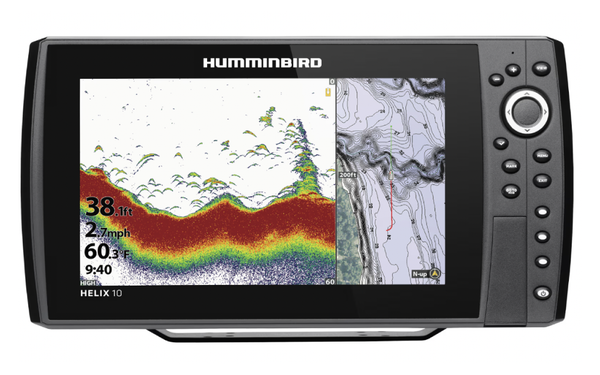
Pros
- Full range of compatible sonar types
- Crisp, easy-to-read display
- Accurate GPS
Cons
The bright 10-inch screen on the Humminbird Helix 10 offers enough space to run multiple functions in split-screen mode, and still provides a clear view. It lets you keep an eye on contour charts while fishing. We also like the color shading for quick reference to the depth being fished. It makes it extremely easy to see if the boat has drifted off the ideal depth or not. The GPS here is very accurate, so you can mark smaller brush piles and pieces of cover that are easily lost.

With WiFi, ethernet and Bluetooth interfaces, you can communicate with the trolling motor, downrigger, and other Minn Kota and Cannon electronics from the Helix 10. Additionally, this fish finder is versatile. It’s right at home either behind the console or up next to the trolling motor. While the Helix 10 is right on the fringe of our ideal size for a fishing kayak, it’ll work there too.
Because this unit is fully loaded, it is rather expensive at around $2,000. However, it’s also a unit that’s frequently on sale.
Specs
- Screen Size: 10.1 inches
- Display Pixel Matrix: 1024 x 600
- Sonar Types: Dual spectrum CHIRP, side imaging, down imaging, Mega Live Imaging, Mega 360
Best Side Imaging
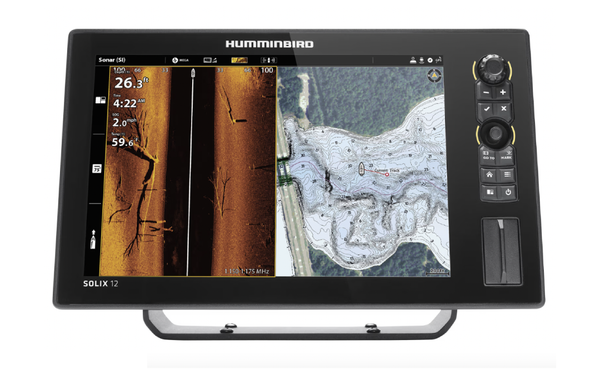
Pros
- Can utilize all Humminbird sonar types
- Large screen makes for great detail
- Touchscreen and button control
Cons
Side imaging covers a wide swath of water, as much as 200 feet on either side of the boat. Thus, we felt it’s best to go with a larger display for interpreting the smaller details. That’s what the Humminbird Solix 12 offers. It’s large, but it doesn’t feel like overkill, either. This is the perfect unit to mount on the console behind the steering.
I used the Solix 12 while fishing in Iowa with walleye pro Mark Courts last year. It impressed me with how well we were able to see the display from almost anywhere on the boat. We were able to easily mark not just individual fish, but also bottom changes and bluegill beds.

The unit’s touchscreen display allowed me to zoom in on individual fish and structure spotted on screen. I was also able to mark promising-looking spots and return to them later. This is the unit to consider for anglers who want full functionality across the Humminbird line. It’s compatible with every sonar type. Mega Live imaging is especially easy to interpret with this display.
Specs
- Screen Size: 12 inches
- Display Pixel Matrix: 1280 x 800
- Sonar Types: Dual Spectrum CHRIP, side imaging, down imaging, Mega Live
Best for Kayak Fishing
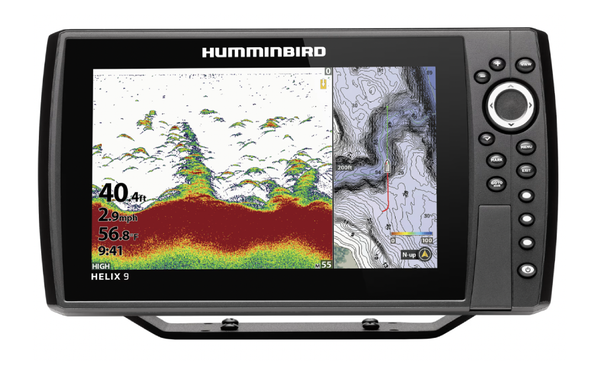
Pros
- Versatile setup
- Solid size for kayaks
- Compatible with many sonar types
Cons
- Large transducer isn’t easy to mount on a kayak
- Cable management is a challenge
I mounted the Humminbird Helix 9 to a 12-foot Old Town PDL kayak and found it to be one of the best fish finders for kayaks. While pedaling around my local lake, I realized I was utilizing many of the same features of larger, more expensive systems on bigger boats.
This unit’s 9-inch screen seems to be the sweet spot for kayaks. It’s large, but not so much that it interferes with casting. I enjoyed fishing with the Helix 9 on a kayak so much that I’m planning to mount a Mega live imaging transducer to it sometime this spring. It has effectively transformed the way I fish from a kayak without breaking the bank on a full-size boat.

It was a challenge to mount the larger transducer that was designed for a trolling motor. However, I found an aftermarket mount online for less than $30 that did the job admirably. Otherwise, the only other challenge is managing the long cables that come standard. They are a little long for a craft this size. However, it wasn’t long before I was marking fish, drop offs, and even sunken boats in the lake on the side imaging.
Specs
- Screen Size: 9 inches
- Display Pixel Matrix: 1024 x 600
- Sonar Type: Dual Spectrum CHIRP, side imaging, down imaging, Mega live imaging
Best Portable
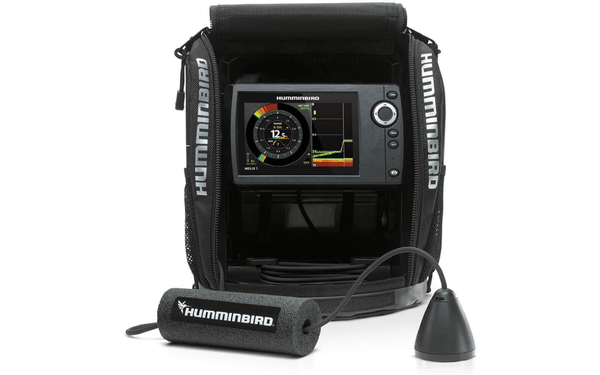
Pros
- Doubles as an ice flasher
- Recharges glow-in-the-dark jigs
- Large, clear display
Cons
The Humminbird Helix 5 houses a powerful fish finder in a protective case complete with battery and transducer, making it one of the best portable fish finders. The Helix 5 CHIRP G3 uses Humminbird’s dual spectrum CHIRP sonar that can be adjusted for the best return image. Combined with the 1024-segment flasher, you can mark bottom structure and individual fish at the same time. To focus on the most productive area of the water column, use the adjustable zoom.
Don’t worry about fishing in a crowd—six settings on the Helix 5 dial in the sonar signal to dial out competing signals. There’s even a Jig Charge Mode to recharge luminescent lures quickly. Bonus: You can easily install the Helix 5 fish finder on your boat for use on open water thanks to the traditional transducer and mounting bracket.
Specs
- Screen Size: 5 inches
- Display Pixel Matrix: 800 x 480
- Sonar Type: Dual Spectrum CHIRP/ice flasher
Best Budget
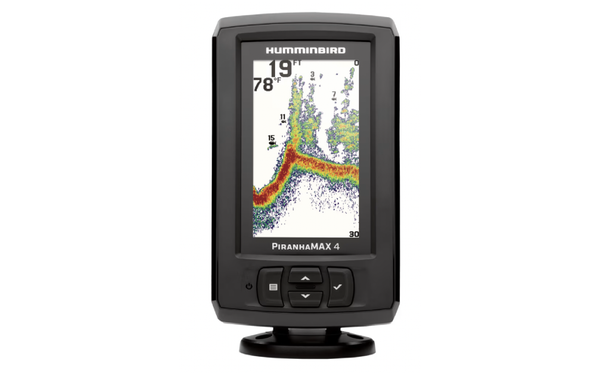
Pros
- Low cost
- Simple interface
- Easy to mount anywhere
Cons
For a small budget-friendly fish finder, the Humminbird PiranhaMax 4 packs a powerful punch for less than $100. The bright, 256-color display makes it easy to determine hard bottom from soft and displays structure such as rocks and deadfalls. You can choose a wide beam for shallow water and a narrow beam to capture more detail in water up to 600 feet deep. The PiranhaMax boasts a sturdy housing and glare-resistant screen and swivel mount—perfect for use on an open boat—and has fish and depth alarm settings.
Specs
- Screen Size: 4.3 inches
- Display Pixel Matrix: 272 x 480
- Sonar Type: Dual Beam
What to Look for in a Humminbird Fish Finder
Humminbird fish finders come in four lines: Apex, Solix, Helix and PiranhaMax. Each offers specific functions, along with features available across the lines. This means you can give up a few conveniences or advanced features and get the depth finder you need within your budget.
To determine the top picks, we balanced features, user interface, and cost. The winner didn’t always have the highest price tag or the most buttons; our picks are the best fish finders for various purposes and budgets.
Sonar Types
Humminbird units offer a full spectrum of sonar types that can fit just about any angler’s budget and needs. Most anglers will find a simple 2D CHIRP sonar to be a perfect entry point into electronics. The display shows fish, structure, and bottom features quite efficiently. These units use transducers that are usually small, easy to mount on any sized craft, and are affordable.
Fish finders with down and side imaging show much more detail of the bottom directly below and to the sides of the boat. These sonar modes make it much easier to visualize what’s going on beneath the surface. The downside is that not every Humminbird unit is compatible with them. The transducers are also larger, and more expensive.
Live Imaging
Humminbird’s Mega Live Imaging is the latest in live sonar tech. It shows a real-time image of everything going on beneath the surface. It’s literally possible to sight fish from the screen using live imaging because you’ll see every movement beneath the surface as it is happening. Misidentification of fish is rare with live imaging because it’s easy to see them moving on screen.
The downside is that this technology is still very new and expensive. Not every Humminbird unit is compatible. The transducer alone goes for about $1,500. Anglers can expect to pay around $3,000-$4,000 for a complete live view setup.
GPS/Mapping
Each angler will have their own preferences on GPS and mapping features in a fish finder unit. It isn’t necessary to have either, but it does make locating fish a lot faster. We prefer Humminbird’s Lakemaster charts because the underwater contour charts make it easy to find places that might hold fish. It also makes it easier to return to these hot spots that hold fish again and again.
The charts are expensive, but Humminbird does offer a nice alternative that rarely gets any attention. That’s the auto chart feature that’s built into some units. Turned on, the unit will literally chart the bottom for the angler. Most units will record about eight hours of data. For anglers only planning to fish one smaller body of water, it’s a nice alternative. It also comes in handy for remote waters that may not be included in Humminbird’s maps.
Screen Sizes and Types
Humminbird builds some great displays that are easy to read in just about any lighting conditions. For most anglers it just becomes a matter of personal preference on screen size. The smaller the screen, the harder it will be to pick up tiny details of the bottom. It can also become harder to separate fish targets from the underwater structure. Although the screen size can also be a concern based on the size of the boat. Some anglers may find a larger Helix or Solix a little too big for a kayak or canoe.
Humminbird offers touch screen capabilities on their Apex and Solix lines. It’s more of a personal preference thing. We love touch screens, but we also know some anglers do not. Especially if your hands are constantly transferring grime to the screen. Consider the push-button Helix series if you aren’t interested in a touch screen model.
FAQs
Q: How do I choose a Humminbird fish finder?
Humminbird offers four distinct lines of fish finders, with a variety of models in each line. The Apex series offers all the bells and whistles in screens up to 18.5 inches wide. Step down to Solix for most of the same features in a smaller screen size. Sacrifice the touch screen and save some money with the most popular Helix line. The PiranhaMax series make for great budget options, and do not skimp on features.
Q: Is Humminbird side imaging worth it?
Side imaging has become a hugely popular tool because it makes it so easy to cover vast swaths of water in a hurry. The development of the tech subsequently led to 360-imaging and live-view, for complete coverage of the water around the boat. Humminbird’s MEGA sonar is the first to use signals over one megahertz to provide the clearest and most detailed imagery. Side-imaging sonar displays fish and structure up to 200 feet on either side of the boat. That’s a huge advantage when finding fish on unfamiliar waters.
Q: How do you identify fish on a Humminbird fish finder?
Fish will appear differently on a fish finder depending on the mode being used. With CHRIP, fish will appear as a distinctive arch. Down imaging can show the exact outline of a fish with enough detail to identify the species. On side imaging, fish tend to show up as shiny white specks or shapes. If the fish is close enough to the bottom, it’s possible to see a shadow sometimes. Humminbird finders do have an option to put a fish icon on possible targets. Although many experienced anglers do not use it simply because it can sometimes make mistakes. And it’s easy enough to identify fish without it once one learns what the display is showing.
Q: What is the best setting for a Humminbird fish finder?
There is no “one size fits all” setting for any fish finder. Mainly because factors like water clarity, depth, temperature, and plankton blooms can all cause interference that varies day to day. Tweaks to the color of the display, the sensitivity, and the dynamic contrast are common when switching between water bodies. Changing these settings can make a huge difference when separating targets from other underwater clutter.
What Is the Best Humminbird Fish Finder?
We feel the Humminbird Helix 5 CHIRP GPS G3 is one of the best values in fish finders today. It’s the ideal starting point for any angler who’s never used electronics before and will work on bodies of water big and small. Combine the size, features, and an excellent price point, and it’s a total winning package for the average angler.
Why Trust Us
For more than 125 years, Field & Stream has been providing readers with honest and authentic coverage of outdoor gear. Our writers and editors eat, sleep, and breathe the outdoors, and that passion comes through in our product reviews. You can count on F&S to keep you up to date on the best new gear. And when we write about a product—whether it’s a bass lure or a backpack—we cover the good and the bad, so you know exactly what to expect before you decide to make a purchase.
Read the full article here



